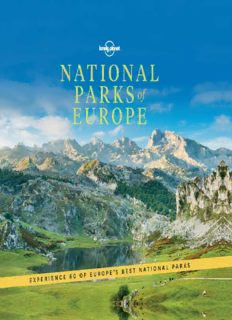
National Parks of Europe PDF
Preview National Parks of Europe
Contents Introduction Abisko Abruzzo Aigüestortes i Estany de Sant Maurici Arcipelago di La Maddalena Atlantic Islands of Galicia Dolomiti Bellunesi Berchtesgaden Black Forest Brecon Beacons Cairngorms Carpathian Cinque Terre Connemara Curonian Spit Dartmoor Doñana Durmitor Écrins Etna Gauja Golfo di Orosei e del Gennargentu Hardangervidda Hohe Tauern Hortobágy Jostedalsbreen Jotunheimen Killarney Kornati Lahemaa Lake District Lake Skadar Lemmenjoki Loch Lomond and The Trossachs National Marine Park of Alonnisos and Northern Sporades Nordvest-Spitsbergen Ordesa Oulanka Paklenica Peak District Pembrokeshire Coast Peneda-Gerês Picos de Europa Pirin Plitvice Port-Cros Pyrenees Retezat Sarek Saxon Switzerland Sierra Nevada Slovenský Raj Snæfellsjökull Snowdonia Swiss Tatras Triglav Valbona Valley Vatnajökull Vikos-Aoös Wadden Sea Acknowledgements Introduction My first sight of Italy’s Cinque Terre National Park was through the train window as I headed south along the coast from Genoa. It was painfully brief. And the same could be said for my second… and third looks. Mere glimpses of the beautiful Ligurian coast, each a fleeting snapshot between the blinding darkness of lengthy rail tunnels. My upset with the subterranean tracks didn’t last long, however, as I was soon gaping at the full coastal splendour of the Cinque Terre from the village of Vernazza’s splendid natural harbour. Cliffs plunged into the sea, forested hills marked the horizon and ancient drystone walls formed twisting terraces above town. And there was not an unsightly train track in view. The stunning vistas only grew in magnitude over the coming days as I ran the steep and precipitous coastal trails linking the Cinque Terre’s five medieval villages. Mix in some lovely beaches, great Italian seafood and gelato, and the park was a truly rewarding experience. This diversity is carried through to Europe’s national parks as a whole, and that is what makes them so special. They protect areas of coast, high-altitude peaks in the Pyrenees and Alps, and even parts of the frozen Arctic, with wildlife ranging from Carpathian squirrels and fin whales to peregrine falcons and polar bears. Setting out to choose Europe’s top 60 national parks was no easy task, so we called on our expert writers and well-travelled Destination Editors. We asked them to tell us which parks provide the best experiences and why. The final selections were those that offered something truly unique, often an enthralling mixture of stunning natural beauty, incredible wildlife, fulfilling activities, local culture and (occasionally) a compelling history too. But this book is intended to be more than just a celebration of Europe’s top national parks – it’s also a practical introduction to each of them. We highlight the best activities and trails – in the case of Port-Cros , one of the trails is actually below the Mediterranean’s surface! – explain how to get there and where to stay, show you the wildlife to watch out for, and even suggest itineraries. We hope the following pages inspire you to explore more of Europe’s wild and wonderful spaces. Matt Phillips THE MEDIEVAL FISHING VILLAGE OF MANAROLA IN THE CINQUE TERRE. SHUTTERSTOCK/SERENAROSSI 01 SWEDEN Abisko National Park Beyond the Arctic Circle, Abisko is the northern gateway to the legendary Kungsleden (King’s Trail) that takes you across 440km of wild Sweden. If you stand on top of the alpine massif of Mount Kebnekaise – Sweden’s highest mountain – you’re looking down at a pristine landscape wrestled from the grip of an ice age. Glaciers still stretch across the flanks of the neighbouring mountains and, while their larger brethren have retreated from the valleys that they once filled completely, the deep, narrow canyons and steep rock walls testify to a violent geological past. Everything is on a larger scale here. You hike for an entire day and realise that you’re not even halfway along the Tjäktjavagge valley. Lakes Torneträsk and Akkajaure are like two inland seas. The birch and spruce forests that cover the foothills seem endless. Abisko National Park came into being in 1909, making it one of the first in Sweden. Forming part of Sápmi, the historic roaming lands of the Sámi that span a large part of northern Sweden, Norway, Finland and Russia’s Kola Peninsula, Abisko has been home to Sweden’s only indigenous peoples for thousands of years. Their hunter ancestors followed the retreating ice into Abisko’s valleys after the last ice age, 10,000 years ago, and remains of ancient hearths and pit traps used to capture wild reindeer and elk can still be found today. Centuries ago, the Sámi switched from hunting to herding, and reindeer husbandry is still prevalent in Abisko, divided between the forest Sámi and the mountain Sámi communities and dictated by the seasons. Forest mountain Sámi communities and dictated by the seasons. Forest reindeer herding is more stationary, with the forest Sámi moving their reindeer between foraging grounds in the wetlands and coniferous forests. The more nomadic mountain Sámi follow their reindeer along ancient migratory routes from low-lying birch and coniferous forests to summer pastures in the mountains, corralling them along the edges of the Kebnekaise range.
Description: